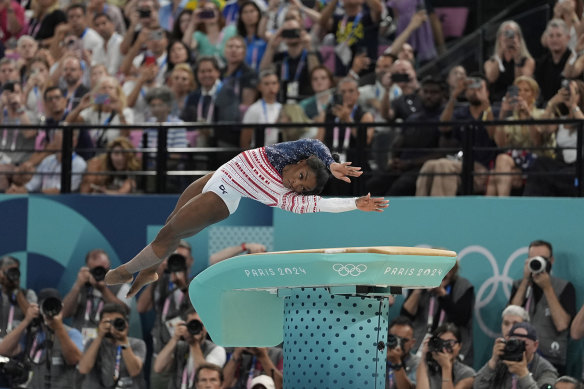- Analysis
- Sport
- Paris 2024
Why the brain is just as important in gymnastics as physical strength
As the world’s top gymnasts compete for the title of the best all-around gymnast, the pressure to perform the perfect tumbling pass on the floor or a double twisting salto – a midair somersault – on the vault will be huge.
These are some of the most difficult physical tasks any human can perform, but they’ll be a necessary addition to the routines that take home gold.

Simone Biles, of the United States, performs on the vault during the women’s artistic gymnastics team final.Credit: AP
Millisecond timing is needed to land them perfectly, with barely a wobble. Not only are these physical feats extremely difficult to do, even after many years of training, they also have to be done while the crowd roars for other gymnasts performing elsewhere at the same time.
But as the world’s elite try to achieve physical perfection, they’ll also be performing extraordinary mental feats that most of us can scarcely comprehend.
Our nervous systems are bombarded with millions of bits of information to process every second during complex physical tasks (remember, a “bit” or binary digit is a single number – 0 or 1 – in computer language).
Yet, the processing capacity of the conscious human mind is only around 120 bits per second – just a fraction of what’s needed to play a song on a computer (2000 bits/sec) or stream a movie (24 million bits/sec).
We might, for example, be able to listen to two people speaking simultaneously, but certainly not three. But elite gymnasts have to process all the data from their eyes, ears and limbs to execute the incredible elements required to win Olympic gold.
The solution to the information processing problem? Do most of the real-time processing in the subconscious mind.
Gymnasts train with a specific purpose to learn to filter out external distractions and maintain laser-focused attention on the task at hand. This requires practise at using their subconscious processing capacity to make up for the shortfall of their conscious capability.
To accomplish this is an extraordinary feat that requires years of dedicated practise, their minds doing as much training as their bodies.
Even for these supremely skilled athletes, things can go awry. A slight error on one element such as landing a somersault means the gymnast starts the next element off-balance. Their brains must make split-second recalculations to compensate mid-routine.
Attempting manoeuvres such as a double twisting somersault from that unstable position becomes mind-bogglingly difficult. But at the highest level, the years of training elite gymnasts do allows their bodies and brains to make the necessary adjustments automatically, subconsciously and rapidly.
It’s these incredible mental capabilities, in addition to their physical brilliance, that is rewarded with the highest difficulty scores in Olympic gymnastics.
As the individual all-around events gets under way in the gymnastics, the noise will be immense, and there will be numerous distractions inside the arena.
So, while you watch in awe at the physical spectacle, remember that the ability to execute the tremendously complex skills with peerless mental focus and precision will likely separate the gymnasts who win medals from those who leave empty-handed.
Sign up for our Sports Newsletter to get Olympic Games updates and general sport news, results and expert analysis straight to your inbox.